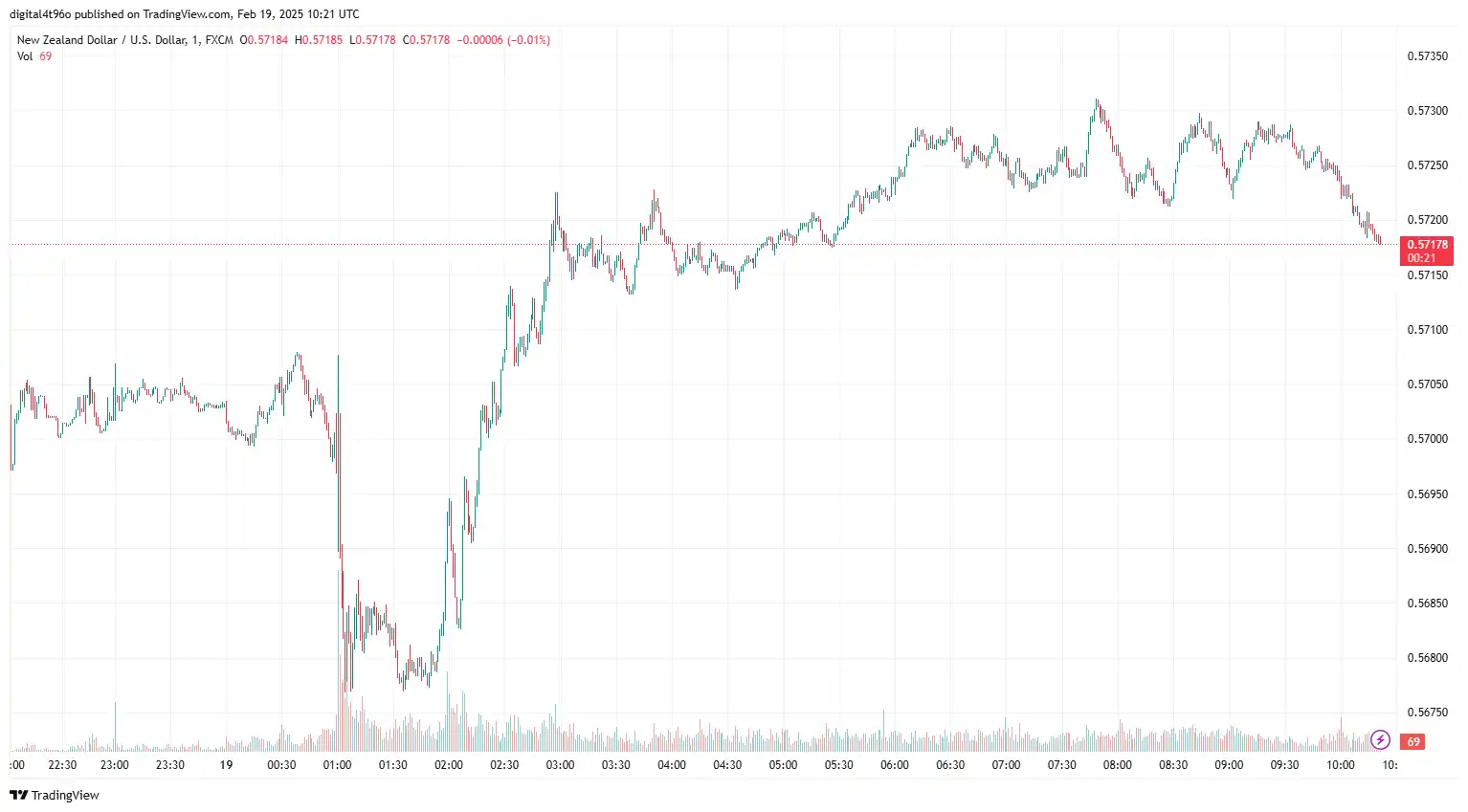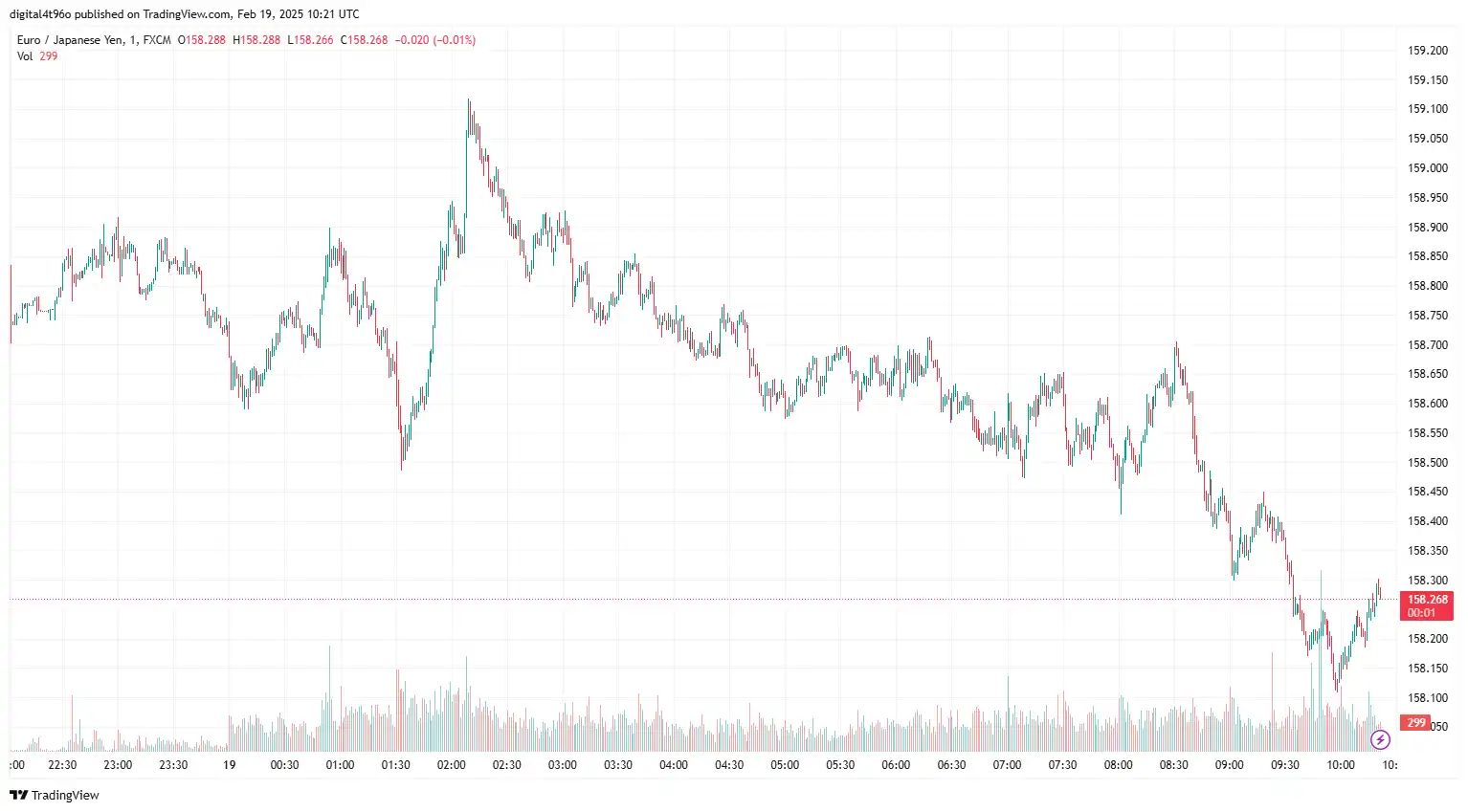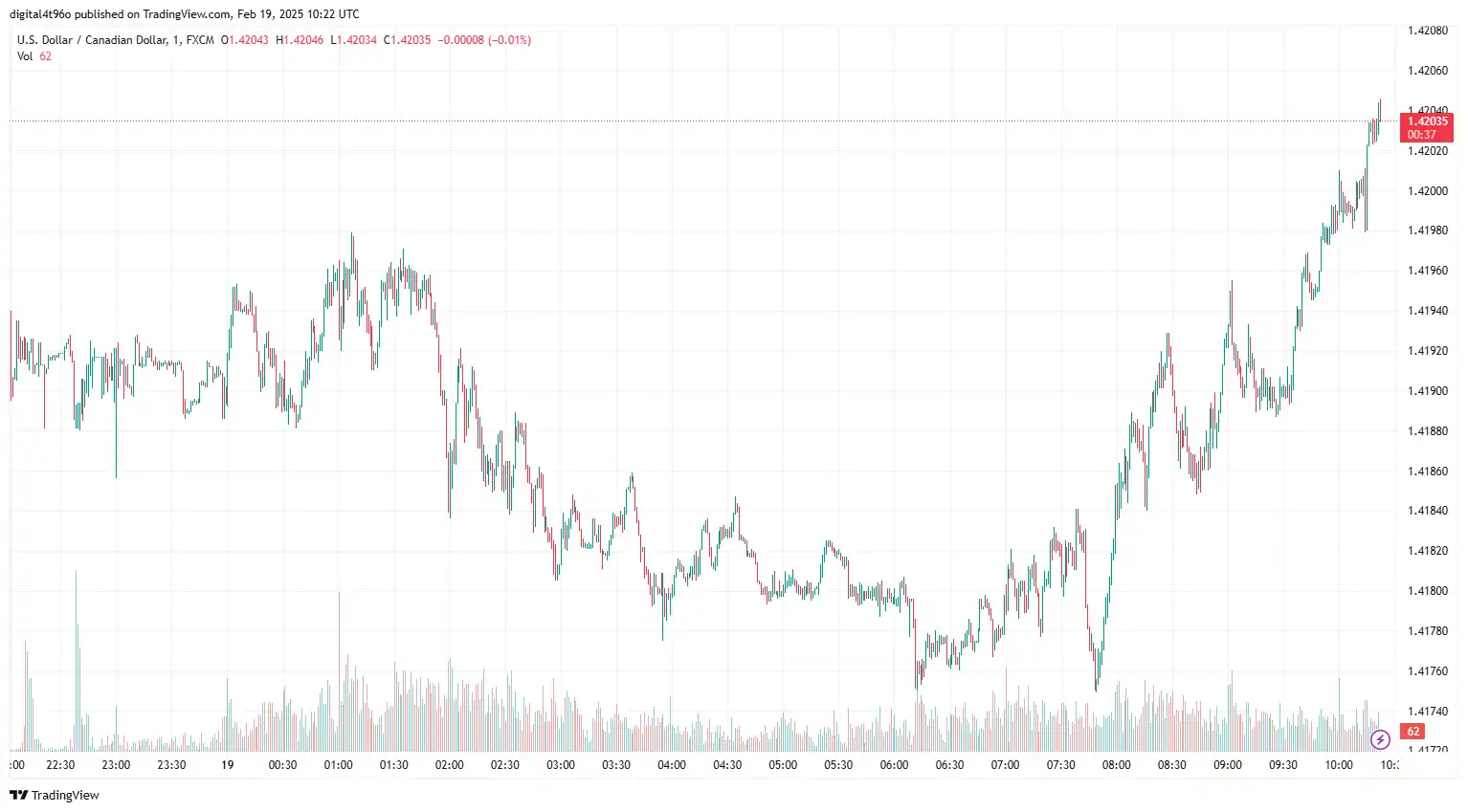GBP/USD remains under pressure near 1.2618 following the release of UK inflation data. The Consumer Price Index (CPI) increased by 3.0% year-on-year (YoY) in January, rising from December's 2.5% gain, surpassing market expectations of 2.8%. In January, the monthly CPI inflation fell to -0.1%, down from +0.3% in December, beating market predictions of -0.3%. At the same time, Core CPI, excluding fluctuating food and energy prices, rose 3.7% YoY, matching market expectations and increasing from December's 3.2%. Furthermore, services inflation jumped to 5.0% YoY in January, up from 4.4% the month before. The inflation figure remains significantly above the central bank's 2% target, which could restrict the Bank of England (BoE) from further monetary easing.
BoE Governor Andrew Bailey recently expressed concern over the British economic outlook, saying, "We are in a period of heightened uncertainty. We are facing a weak growth environment in the UK." On Tuesday, the ILO Unemployment Rate held steady at 4.4% for the three months to December, surpassing expectations of an increase to 4.5%. The Claimant Count Change showed a rise of 22K in January, contrasting with a decline of -15.1K in the previous month (revised from +0.7K), failing to meet the predicted 10K increase. Average Earnings data, a key indicator of wage growth, picked up in the three months ending in December. As anticipated, Average Earnings Excluding bonuses climbed to 5.9%, up from 5.6% in the previous report, while Average Earnings Including bonuses rose by 6%, exceeding both the forecast of 5.9% and the last reported figure of 5.6%.
Following Tuesday's President Trump speech, improved risk sentiment strengthened the US dollar. He commented, "I probably will tell you that on April 2, but it'll be in the neighbourhood of 25 per cent. It'll be 25 per cent and higher, and it'll go very substantially higher over the course of a year." He added, "When they come into the United States and they have their plant or factory here, there is no tariff, so we want to give them a little chance," while talking about businesses. On the economic front, the Empire State Manufacturing Survey exhibited that the headline General Business Conditions Index climbed eighteen points to 5.7 from the prior -12.6 and against the predicted -1.9.
In upcoming sessions, investors will pay attention to Friday's UK Retail Sales data for January, the preliminary S&P Global/CIPS Purchasing Managers Index (PMI) data for February, and highly anticipated FOMC Meeting Minutes for further guidance on GBP/USD's movements.

NZD/USD Buoyed Despite RBNZ's Supersized Rate Cut
NZD/USD holds gains near 0.5725, recovering from the challenges following the Reserve Bank of New Zealand's (RBNZ) decision to lower the Official Cash Rate (OCR) by 50 basis points from 4.25% to 3.75%. Moreover, monetary policy meeting minutes hinted at the scope for further policy easing. During the post-meeting press conference, RBNZ Governor Adrian Orr remarked that the OCR path predicts a 50-basis-point reduction by mid-year, likely around July, in two increments of 25 basis points each. The economy has considerable spare capacity, making rate cuts in April and May suitable.
On the economic front, the Business NZ Performance of Services Index (PSI) climbed to 50.4, an improvement from a revised 48.1 in December, indicating a slight rebound in the services sector after ten months of downturn.
Meanwhile, the Business NZ Manufacturing Index rose to 51.4, up from the previous 46.2. The NZ business price indexes performed mixed in the December 2024 quarter compared to the September 2024 quarter. The Output Producers Price Index (PPI) declined by 0.1%, while the Input PPI fell by 0.9%. The Farm Expenses Price Index (FEPI) also dropped by 0.1%. On the other hand, the Capital Goods Price Index (CGPI) rose by 0.4%.
The greenback struggles to maintain its position amidst declining Treasury yields and the expectation that the Federal Reserve (Fed) will further reduce interest rates this year. On Monday, Federal Reserve Governor Michelle Bowman remarked that rising asset prices may have hampered the Fed's recent progress on inflation. While Bowman anticipates a decline in inflation, she warned that there are still upside risks and stressed the necessity for greater certainty before contemplating rate cuts. Fed Governor Christopher Waller recognised that although inflation has improved, the progress has been "excruciatingly" slow and emphasised that the Fed must avoid allowing policy uncertainty to obstruct data-driven decisions.
The broader market sentiment around the FOMC minutes, the RBNZ's interest rate decision, and concerns about Trump's reciprocal tariffs will significantly influence the NZD/USD pair.

EUR/JPY Sinks on Upbeat German Data
EUR/JPY weakens near 158.38 as growing anticipation that the Bank of Japan (BoJ) will resume increasing interest rates to combat persistent inflationary pressures supports the yen. However, weaker-than-expected economic data could limit the upside of the currency. Japan's core Machinery Orders, excluding ships and electric power, dropped 1.2% month-on-month in December 2024, contrasting the prior month's 3.4% increase, falling short of the anticipated gain of 0.1%, marking the largest decrease in four months. Meanwhile, Japan's trade deficit widened sharply to JPY 2,758.78 billion in January, up from JPY 1,766.54 billion a year prior, surpassing market forecasts set at JPY 2,100 billion. Imports surged by 16.7% year-on-year, reaching a 26-month high, significantly surpassing December's 1.7% growth and exceeding expectations of 9.7%. Conversely, exports grew slower at 7.2% year-on-year, marking the fourth consecutive month of growth but falling short of the expected 7.9%. The Japanese economy grew by 0.7% in Q4 2024, an increase from a revised 0.4% in the previous quarter, marking three consecutive quarters of growth. Yearly growth improved from a revised 1.7% in Q3 to 2.8%, strengthening the BoJ's stance on possible future rate hikes.
On Monday, Japanese Chief Cabinet Secretary Yoshimasa Hayashi warned that Japan could face challenges if businesses were affected by President Trump's policies, adding that the government would take a cautious approach to potential impacts. On Tuesday, Bank of Japan (BoJ) Governor Kazuo Ueda acknowledged that the BoJ had not been sufficiently clear in its policy guidance, noting that last summer's market volatility stemmed largely from concerns over weak US jobs data and the broader US economic slowdown. Meanwhile, BoJ Board Member Hajime Takata stated on Wednesday that the BoJ must gradually adjust its policy, even after January's rate hike, to prevent upside price risks from materialising.
On the other hand, sluggish growth in the Eurozone, coupled with rising expectations that the European Central Bank (ECB) will introduce further interest rate cuts, undermines the euro. On the economic front, the Eurozone ZEW Economic Sentiment Index registered at 24.2 in February, up from January's 18.0, falling short of market expectations of 24.3. Recent trade statistics show a €15.5 billion surplus in goods trade with the global market for December 2024, a decrease from the €16.4 billion surplus reported in December 2023. Within the Euro area, goods exports to the global market rose by 3.1%, reaching €226.5 billion, while imports rose by 3.8%, amounting to €211.0 billion. Recent remarks from European Central Bank (ECB) policymaker Fabio Panetta indicated economic weakness in the Eurozone, stating, "We anticipated a recovery driven by consumer spending, but that has not materialised."
With the absence of the EU's economic docket, market sentiment around Russia-Ukraine negotiations and trade tariffs will drive the EUR/JPY's movements.

USD/CAD Rebounds After CPI Inflation Uptick
USD/CAD trades cautiously near 1.4200 as hawkish remarks from Federal Reserve (Fed) officials underpin the US Dollar (USD). On Tuesday, San Francisco Fed President Mary Daly stated that the outlook for further rate cuts in 2025 remains uncertain despite generally positive US economic indicators. Meanwhile, Philadelphia Fed President Patrick Harker reiterated his support for keeping interest rates steady, highlighting the persistent and elevated levels of inflation observed in recent months. Additionally, improved market sentiment following recent remarks from President Trump is suggesting the imposition of tariffs of around 25% on foreign cars, while semiconductor chips and drugs are set to face higher duties. The Empire State Manufacturing Survey indicated that the General Business Conditions Index improved significantly, increasing eighteen points to 5.7 from the previous -12.6, surpassing the expected -1.9.
On the other hand, the hotter-than-expected CPI report supports the Canadian dollar (CAD). The Consumer Price Index (CPI), which tracks the cost of common goods and services, rose by 1.9% from December's 1.8% and aligns with analysts' predictions. Month-over-month, prices increased by 0.1%, recovering from a 0.4% drop in December. In contrast, the Bank of Canada's Core CPI, which excludes volatile categories such as food and energy, showed greater resilience. It rose to 2.1% YoY in January 2025, up from 1.8% the previous month, and experienced a monthly gain of 0.4%, reversing a 0.3% decline in December.
The broader market sentiment around the greenback will significantly influence the USD/CAD pair.

Stay Ahead in the Currency Game
Whether you're a daily FX trader or handle international transactions regularly, our 'Currency Pulse' newsletter delivers the news you need to make more informed decisions. Receive concise updates and in-depth insights directly in your LinkedIn feed.
Subscribe to 'Currency Pulse' now and never miss a beat in the currency markets!
Ready to act on today’s insights? Get a free quote or give us a call on: +44 (0)20 7740 0000 to connect with a dedicated portfolio manager for tailored support.
Important: This blog is for informational purposes only and should not be considered financial advice. Currency Solutions does not consider individual investment goals, financial circumstances, or specific requirements of readers. We do not endorse or recommend any particular financial strategies or products discussed. Currency Solutions provides this content as is, without any guarantees of completeness, accuracy, or timeliness.
Important Disclaimer: This blog is for informational purposes only and should not be considered financial advice. Currency Solutions does not take into account the investment objectives, financial situation, or specific needs of any individual readers. We do not endorse or recommend any specific financial strategies, products, or services mentioned in this content. All information is provided “as is” without any representations or warranties, express or implied, regarding its accuracy, completeness, or timeliness.




